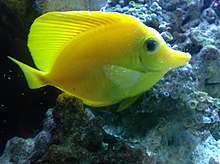Cryptocaryon
| Cryptocaryon irritans | |
|---|---|

| |
Yellow tang with white spots characteristic of marine ich
| |
| Scientific classification | |
| Domain: | Eukaryota |
| (unranked): | |
| (unranked): | Alveolata |
| Phylum: | |
| Class: | |
| Genus: | Cryptocaryon
|
| Species: | C. irritans
|
| Binomial name | |
| Cryptocaryon irritans | |
Cryptocaryon irritans is a species of
Taxonomy
Cryptocaryon irritans was originally classified as Ichthyophthirius marinus, but it is not closely related to the other species. It belongs to the class Prostomatea, but beyond that its placement is still uncertain.
Clinical
The symptoms and life-cycle are generally similar to those of Ichthyophthirius in freshwater fish, including white spots, on account of which Cryptocaryon is usually called marine ich. However, Cryptocaryon can spend a much longer time encysted. Fish that are infected with Cryptocaryon may have small white spots, nodules, or patches on their skin, fins, or gills. They may also have ragged fins, cloudy eyes, pale gills, increased mucus production, or changes in skin color, and they may appear thin. Behaviorally, fish may act different. They may scratch, swim abnormally, act lethargic, hang at the surface or on the bottom, or breathe more rapidly as if they are in distress.[3]
Useful treatments (but not safe for reef tanks or invertebrates) of Cryptocaryon irritans are
diphosphate).Infections can be extremely difficult to treat because of the presence of other creatures in the tank, such as corals and other invertebrates, which will not survive standard treatments. Ideally fish with Cryptocaryon are
See also
- Freshwater ichfor the similar disease of freshwater fishes
References
- ISBN 978-0-8138-0697-6.
- ^ "ich". The American Heritage Dictionary of the English Language (5th ed.). HarperCollins.
- ^ Yanong, Roy P. E. (2009). "Cryptocaryon irritans Infections (Marine White Spot Disease) in Fish". University of Florida.
Further reading
- Colorni, Angelo (December 1987). "Biology of Cryptocaryon irritans and strategies for its control". Aquaculture. 67 (1/2): 236–237. .
- Dickerson, Harry W. (Summer 1994). "Treatment of Cryptocaryon irritans in Aquaria". SeaScope. 11.
- Diggles, B. K.; Lester, R. J. G. (June 1996). "Infections of Cryptocaryon irritans on wild fish from southeast Queensland, Australia". Diseases of Aquatic Organisms. 25 (3): 159–167. .
- Goto, Tsuyoshi; Hirazawa, Noritaka; Takaishi, Yoshihisa; Kashiwada, Yoshiki (16 September 2014). "Antiparasitic effects of Sophora flavescens root extracts on the ciliate, Cryptocaryon irritans". Aquaculture. 435: 173–177. .
- Li, Ruijun; Dan, Xueming; Li, Anxing (December 2013). "Siganus oramin recombinant L-amino acid oxidase is lethal to Cryptocaryon irritans". Fish & Shellfish Immunology. 35 (6): 1867–1873. PMID 24113573.
- Lin, Qianqian; Yang, Mei; Huang, Zhen; Ni, Wei; Fu, Guoliang; Guo, Guowei; Wang, Zhengchao; Huang, Xiaohong (8 November 2013). "Cloning, expression and molecular characterization of a 14-3-3 gene from a parasitic ciliate, Cryptocaryon irritans". Veterinary Parasitology. 197 (3–4): 427–435. PMID 23932453.
- Yin, Fei; Gong, Qiyang; Li, Yanwei (February 2014). "Effects of Cryptocaryon irritans infection on the survival, feeding, respiratory rate and ionic regulation of the marbled rockfish Sebastiscus marmoratus". Parasitology. 141 (2): 279–286. S2CID 22057733.
External links

